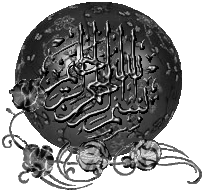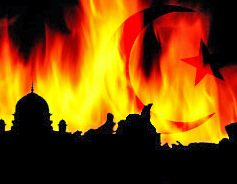Part 3

History of the Arabs
PART 2 - PREISLAMIC ARABIA
Al Jahiliyah...
This is a term used extensively in Muslim Arab terminology which actually means "time of ignorance"; that is, ignorance of a revealed book, and hence the revelation of the unity and oneness of God. Before the advent of Muhammad, the Arabians had religious and social traditions that were later almost completely incorporated by him into Muhammadan theology with minimum if any modifications. Unlike the South Arabians who were a more urban group, the North Arabians of Najd and Al Hijaz, were mostly nomadic. The sedentary populations of the above developed no ancient culture of their own. They had no system of writing and the only information about them comes from oral traditions, proverbs, legends and mostly poems that were orally transmitted down the decades. Most of these were later committed to writing two to three hundred years later (822/922 CE), that is two to four hundred years after the events that they were supposed to represent. It is a recorded historical fact that the North Arabians did not develop a system of writing until after the death of Muhammad c.635CE.
Arabs before Islam...
The Arab tribes of the Jazeerah (Peninsula) - Christian, Pagan or 'Jewish' - fought each other over the acquisition of water resources, over blood feuds and over supremacy. Each individual Arab was known and identified by the name of the tribe to which he belonged.
Although all the people of the peninsula were Arab, there was no such thing as a sense of unity or nationalism. Each tribe was a separate and independent entity, with different dialects and religious belliefs and had no feeling of affinity or loyalty to any other except in terms of mutually beneficial and convenient alliances. The sense of the 'Umma al Arabia', the nation and people of Arabia, was achieved only after all of Arabia was subjugated and united under Muhammad..
Social structure...
The Bedouin tribe (Qabilah) was organized in clans. The nucleus of the tribe was the tent (Khaymah) which represented a family; an encampment of tents formed a (Hayy). Members of one (Hayy) constituted a clan (Qawm). A number of kindred clans grouped together formed a tribe (Qabilah). The members of each clan are invariably blood-related.
The Bedouins are very democratic as far as their leadership is concerned. Only the wisest and most experienced of the clan members is elected leader (Sheikh); they are not hereditary. The leader is only primus inter pares; one among equals. His tenure in office lasted during the good will of his constituency. The name of each clan starts with the prefix (Banu) which means the children or descendants of. Tribal members share in common all pasturage, water and cultivable land; only the tent and its contents belong to the individual.
The Muslim state made full use of the tribal system for its military conquests and settlements purposes. The army was divided into divisions based on tribal affiliations to keep their cohesion and loyalty. The conquered territories were settled by tribes, that treated the new converts from among the subjugated peoples as 'clients' (Mawali).
Religion...
In general, the pagan Arabs - the majority in Arabia - had a very primitive and simple astral and animistic religion of at least 360 gods and goddesses. Among the gods of the pagan Arabs, Allah was one of the most important. In Mecca, Allah was the principal though not the only deity. He had three daughters: Al Lat (Crescent); Al Uzzah (Venus) and Al Manah (Fate) (53:19/20). Besides the Ka'ba of Mecca, caves, trees, waterholes, wells etc. were also venerated especially in a bleak, arid and desolate land as theirs. There were other 'holy' sites also called Ka'ba besides the one in Mecca, such as the ones in Petra, Sana' and Najran.
The sun too was worshipped but not to the same level of importance as the moon. After all, Moon worship in general implies a nomadic and pastoral society, whereas Sun worship is invariably associated with an agricultural one. Most important of all is that in the scorching furnace heat of the Arabian desert, the Sun is actually an enemy of the nomads depriving them of pasture, shade and water. On the other hand, the moon is their friend and ally providing them with light, coolness of the night, dew and shade; and this is reflected in its greater importance as a deity for them.
The pagan Arabs built no temples or special structures for their gods, unlike all the surrounding civilizations. They developed no elaborate mythology, no structured theology and no cosmogony comparable to that of any of their neighbours.
The pagan Ka'ba was a special but very simple cube-like building that housed a fallen black meteorite, which was venerated as a fetish. Because of its holiness, the area surrounding it was pronounced prohibited/sacred (Haram). Even before 'Islam', it was an object of annual pilgrimage and sacrifice.
Most of the 'holy' places of their other divinities were trees, wells, caves or fallen meteors. The pagan Arabs made sacrifices - both human and animal - to 'Venus' (Al Uzzah) and it is recorded that Muhammad participated in giving sacrifices to this goddess as a young man. The Bedouins also believed that the desert was full of living creatures/spirits called Jinn whose purpose was to blight their lives with mischief and difficulties. Since nomadic people bury their dead on the move and hence have no special resting-places such as graveyards, they subsequently had no special reverence for their dead nor any concept of an afterlife, of resurrection, a day of judgment or heaven and hell; these came with 'Islam'.
The pagan Arabian calendar was a lunar one. The first three months of its Spring season coincided with the period of 'peace': dhu-al-Qa'dah; dhu-al-Hijjah and Muharram. These were the months of 'Holy Truce' when the usually warring tribes laid aside their hatreds and warfare and concentrated on offering sacrifices to their pagan gods and visiting their 'holy' sites. The Ukaz Fair in this period was used to trade and recite poetry. In pre-Islamic days, the annual fairs of North Arabia were followed by a pilgrimage in dhu-al-Hijjah to the Ka'ba and mount Arafat. Almost every one of those primarily pagan rituals, fetishes and traditions was later - out of desperation and for convenience - incorporated by Muhammad in his own version of 'Islam'.
The Arabian Peninsula harboured, besides the indigenous tribes who followed the traditions of the Jews and the Christians, were the Sabeans and the 'Hanifs' who were believers in the One and Only God of Abraham; these latter must have been off-shoots from either the 'Jews' or the Christians or both.
Culture...
Contrary to all of Arab propaganda and historical falsifications, there was no Arab civilization to speak of where Muhammad grew up. Civilization requires a central government, administrative personnel and documentation, cities, art, sculpture, temples and priesthood, an army, etc. These were totally lacking in his days. The Arabs of Mecca and Medina did not have any of these attributes; they left posterity no monuments or temples and no records of their achievements. They had absolutely nothing remotely resembling either the Byzantine or Persian civilizations.
Tribes on the move - whether on horseback or camelback - can never bring about a civilization, neither can an extremely hostile and impoverished land.
The Arabs of Al Jahilyah (before Muhammad), left almost nothing in writing. No national epic was ever developed by the Arabians and no dramatic work of first-class importance. This is in unfavourable contrast to the Hebrews, Assyrians, Babylonians or the Egyptians who had a much more advanced literary, written and oral traditions; the Arabs on the other hand had mostly their oral one. They were the least literate among the peoples of the Middle East. Their language was their greatest legacy.
The Bedouin's love of poetry was his only cultural asset and legacy. Their poets were held with great esteem and were extremely influential because of their mastery of the spoken word. They acted as the historians, propagandists and spokesmen of their tribes. They were in fact the equivalent of the modern news media reporters.
Although poetry reigned supreme among the Arabs of Al Hijaz and Al Najd (north-western and northern Arabia), prose was not well represented in the Jahiliyah literature since no system of writing had yet been fully developed and there is no trustworthy record of any Arabic literature before the Quran. This evolution started to occur just after the death of Muhammad as it was propelled by the imperative necessity to write down as much of the Quran as possible before all those who had memorised it had died of old age or killed in the battles of the civil wars that followed his death.
Despite all attempts by Muhammadan theologians to pervert the historical record, it is very clear that Muhammad did not get his 'inspirations' and the Quran in a vacuum; he was surrounded by all types of cultural influences: religious, material and intellectual emanating from Persian, Byzantine, Aramaean and the 'People of the Book', especially in the part of the peninsula (al Hijaz) where he grew up.
Most of the important stories in the Quran show that they were derived from the Hebrew Bible and the New Testament.
His wife Khadija, after all, was a Hanif associated to a Christian tribe - as mentioned by Arab historians in many sources - since her cousin Waraqa, was a Christian.
Muhammad did not invent, create or discover the concept of the One and Only God because it was the effect of all these external influences that inspired Muhammad to create for his pagan Arabs, a scripture similar to that of the People of the Book.
The Scene...
Current wisdom, among historians, states that the conditions in the Arabian Peninsula were perfectly suited for a drastic change; a change to greater cohesion and uniformity and that Muhammad turned out to be the man for that moment in history.
The above is neither correct nor true, since Muhammad did not unite the Arabs of the Peninsula through dialogue, persuasion and debate - wherein he failed miserably in the first 13 years in Mecca - but because he succeeded in 'uniting' the Arabs only through the application of force, terror, assassination and ruthlessness as fully described in both his Quran and Ahadith.
It is a historical fact that many of the same Arabs who had earlier falsely 'submitted' to him, apostatized the moment he died and was not there anymore to terrorize them.
Once again, they had to be brought into 'Islam' by the application of the sword on a massive scale in the Wars of Apostasy/ Huroub al Ridda, during the Caliphate of Abu Bakr.
